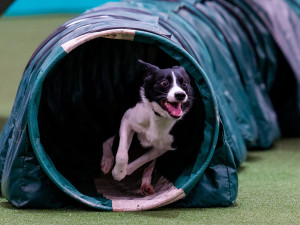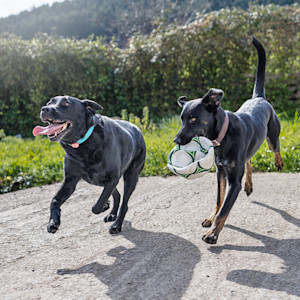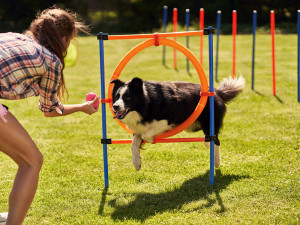Meet Mantrailing: The Sport Where Your Dog Leads the Way
Fancy putting your dog’s nose to the test?
You may not have heard about mantrailing before but it’s safe to say that the canine scent training is growing in popularity all over the world, thanks to its many benefits for both dogs and pet parents alike. Mantrailing, an inclusive and engaging dog sport, appeals to pet parents looking to provide both physical exercise and mental stimulationopens in a new tab for their dogs, regardless of breed, age or ability. Beyond the UK, mantrailing is gaining traction in the US, with workshops and classes offered at various levels to suit different needs across the states.
What is mantrailing?
Mantrailing is a dog-led scent-tracking activity where dogs follow a specific human scent trail, a skill derived from search and rescue operations where dogs must use their nose in order to locate a missing person.
Get (totally free) deals for food, treats, accessories, tech and way more pet parenting must-haves.
Unlike competitive dog sportsopens in a new tab, this form of scent training focuses on teamwork and communication between dog and human, making it a popular choice for pet parents who want to strengthen their bond with their dogs while providing a meaningful outlet for natural canine instincts.
How does mantrailing work?
Mantrailing classes, often run by trained professionals, can be found locallyopens in a new tab and are tailored to maximise the benefits for both dogs and their humans. Tony Briggsopens in a new tab, a canine behaviour coach and mantrailing expert, explains the core steps in the process:
Scent article: a personal item belonging to the target person is selected, something like a worn item of clothing or an object they’ve touched, ensuring it’s uncontaminated by other scents (including other people).
Set-up: the area where the target person was last present is prepared by allowing the dog to sniff and explore, “this is when the dog will naturally encounter all the scents left in the area,” says Tony.
Harnessing and scents: the dog is fitted with a trailing harness and long line, then introduced to the scent article to memorise the scent from it (when previously trained).
Following the trail: “we cue the dog to trail, and if the scent on the article matches a scent trail in the area the dog will set off and follow the trail,” says Tony.
Reward: once the dog reaches the target person at the end of the trail, they’re rewarded through play or or food, “mimicking the instinctive prey drive sequence of the dog”.
Tony harnesses the dog’s natural abilities by setting up achievable situations for them to problem solve and learn. “Learning to communicate with and understand our dog is the real art of mantrailing,” he says. “They are not machines they are thinking feeling beings, who enjoy our company almost as much as we enjoy theirs.”
Benefits of mantrailing for dogs and pet parents
Mantrailing has become more than just a sport; canine scent training is a rewarding activity that offers a range of benefits. We spoke to Mantrailing Globalopens in a new tab who offered their expert advice on the top benefits of mantrailing, including some surprising insights:
Mental stimulation: mantrailing provides dogs with mental exercise as they engage their sense of smell, problem-solving abilities and short bursts of concentration.
Physical exercise: while mantrailing is primarily a mental activity, it still requires physical effort. Dogs burn off energy during the sessions on the trails, which can contribute to their overall health and fitness.
Enhanced bond: working together strengthens the bond between dogs and their parents; mantrailing is a collaborative effort that builds trust, communication and teamwork. Pet parents can learn to read their dogs’ subtle cues and share the excitement of the trail together.
Confidence building: mantrailing training methods are tailored so that any pet dog can take part and enjoy it, even the nervous and reactiveopens in a new tab ones! Mantrailing is choice-based, allowing the dog lead the way and making it a great confidence-building tool that often transitions into the dog’s day-to-day life.
Problem-solving skills: mantrailing challenges dogs to use their problem-solving skills to follow a scent trail and make decisions independently.
Emotional well-being: engaging in mantrailing can contribute to a dog and owners emotional well-being by reducing stress and anxiety. The mental stimulation and positive interactions, as well as spending time outdoors, helps create a sense of contentment and happiness.
Community: many of the dog parents who attend sessions feel that the social aspect of training is just as impactful and important as the mantrailing itself. Creating a space where you can be around likeminded people means they are part of an accepting and understanding community where they can enjoy spending time with their dog without judgment.
Who can do mantrailing?
Mantrailing is one of the most inclusive activities for pet parents and their canine companions. It’s suitable for anyone who wants to challenge and forge a deeper bond with their dog, perhaps without the high energy and fast-paced vibe of agility classesopens in a new tab, for example.
Estelle Vickery of Little Pawsopens in a new tab has an MSc and BSc (Hons) in Animal Behaviour and Welfare explains, “Mantrailing builds confidence and independence. I’ve seen many anxious dogs come out of their shell while mantrailing. It is a great way for your dog to showcase their natural scenting ability while working as a team. As an added bonus, it tires them out more than any other activity. Mantrailing is inclusive of all dog breeds, ages and abilities which makes it a fantastic pet sport”.
How to get started with mantrailing
To start, find a trusted mantrailing instructor in your area, checking reviews to ensure expert guidance. Mantrailing Global also offers a few beginner tips:
Choose the best reward: “what is it your dog loves the most? A toy? Chicken? Blanket? Yummy treats? Bring it! This ensures they are motivated, excited and makes the task of mantrailing worthwhile”.
Read your dog’s signals: learn to recognise when they’re actively trailing, searching, or have lost the trail.
Self-reflect: video your sessions for feedback and keep working on the basics at your own pace.
Enjoy the process: focus on having fun rather than comparing yourself to others. “Remember why you started – to enjoy time with your dog!”
Is mantrailing safe for my dog?
Mantrailing is one of the safest dog sports, ideal for dogs of all ages and temperaments, due to its low-impact and non-aggressive nature. As a very low-impact activity, mantrailing is suitable for older dogs, dogs who are nervous or fearful, and younger dogs who may not be ready for more extensive activity-based training.
Sarah Patersonopens in a new tab, a dog agility instructor with 25 years of experience, has been taking her own dogs to mantrailing classes for a positive experience. She explains, “For me, mantrailing is super safe because dogs work one at a time, connected to you by a long line. It’s calm and thoughtful, making it not only physically safe but also mentally safe, provided you attend a registered instructor.”







